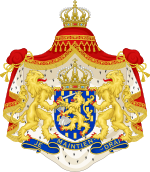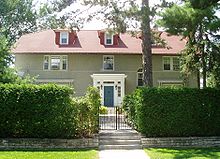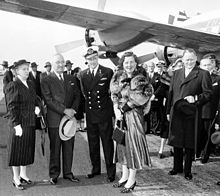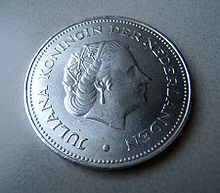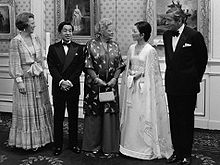- Juliana of the Netherlands
-
For the airport of the same name, see Princess Juliana International Airport.
Juliana 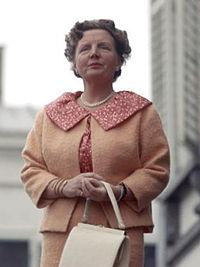
Juliana in 1963 Queen of the Netherlands Reign 4 September 1948 – 30 April 1980
(31 years, 239 days)Predecessor Wilhelmina Successor Beatrix Spouse Bernhard of Lippe-Biesterfeld Issue Beatrix of the Netherlands
Princess Irene
Princess Margriet
Princess ChristinaFull name Juliana Louise Emma Marie Wilhelmina House House of Orange-Nassau* Father Henry of Mecklenburg-Schwerin Mother Wilhelmina of the Netherlands Born April 30, 1909
The Hague, NetherlandsDied March 20, 2004 (aged 94)
Baarn, NetherlandsBurial March 30, 2004
Nieuwe Kerk, DelftReligion Dutch Reformed Juliana (Juliana Louise Emma Marie Wilhelmina; 30 April 1909 – 20 March 2004) was the Queen regnant of the Kingdom of the Netherlands between 1948 and 1980. She was the only child of Queen Wilhelmina and Prince Henry. She was married to Prince Bernhard of Lippe-Biesterfeld, with whom she had four children: Princess Beatrix (born 1938), Princess Irene (born 1939), Princess Margriet (born 1943), Princess Christina (born 1947). During the Second World War she lived in exile with her children in Ottawa, Canada. She became Queen of the Netherlands with her mother's abdication in 1948 and was succeeded by Queen Beatrix after her own abdication in 1980. During her reign both Indonesia (Dutch East Indies) proclaimed in 1945, but recognized in 1949 and Suriname in 1975 became independent from the Netherlands. Her birthday is celebrated annually as Koninginnedag, Queen's Day. Upon her death at the age of 94, she was the longest-lived former ruling monarch in the world. She is commemorated in space, in the name of the asteroid 816 Juliana.
Contents
Early life
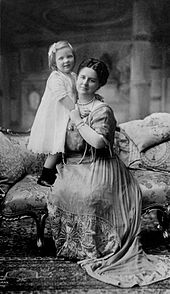 Juliana with her mother, Queen Wilhelmina, circa 1914
Juliana with her mother, Queen Wilhelmina, circa 1914
Born in The Hague, the daughter of Queen Wilhelmina of the Netherlands and Duke Henry of Mecklenburg-Schwerin, Juliana spent her childhood at Het Loo Palace in Apeldoorn, and at Noordeinde Palace and Huis ten Bosch Palace in The Hague. A small school class was formed at Noordeinde Palace on the advice of the educator Jan Ligthart so that, from the age of six, the Princess could receive her primary education with children of her own age. These children were Elise Barones Bentinck, Elisabeth Barones van Hardenbroek and Jonkvrouwe Miek de Jonge.
As the Dutch constitution specified that she should be ready to succeed to the throne by the age of eighteen, Princess Juliana's education proceeded at a faster pace than that of most children. After five years of primary education, the Princess received her secondary education (to pre-university level) from private tutors.
On 30 April 1927, Princess Juliana celebrated her eighteenth birthday. Under the constitution, she had officially come of age and was entitled to assume the royal prerogative, if necessary. Two days later her mother installed her in the "Raad van State" ("Council of State").
In the same year, the Princess enrolled as a student at the University of Leiden. In her first years at university, she attended lectures in sociology, jurisprudence, economics, history of religion, parliamentary history and constitutional law. In the course of her studies she also attended lectures on the cultures of Suriname and the Netherlands Antilles, the Charter of the Kingdom of the Netherlands, international affairs, international law, history, and European law.
Marriage
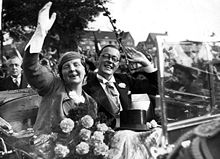 Princess Juliana and Prince Bernhard after their engagement
Princess Juliana and Prince Bernhard after their engagement
In the 1930s, Queen Wilhelmina began a search for a suitable husband for her daughter. At the time, the House of Orange was one of the most strictly religious royal families in the world, and it was very difficult to find a Protestant Prince who suited their standards. Princes from the United Kingdom and Sweden were "vetted" but either declined or were rejected by the Princess.
At the 1936 Winter Olympics in Bavaria, she met Prince Bernhard of Lippe-Biesterfeld, a young German aristocrat. Prince Bernhard was a suave young businessman, and though not a playboy, certainly a "man about town" with a dashing lifestyle. But his rank and religion were suitable, and so Princess Juliana's royal engagement was arranged by her mother. Princess Juliana fell deeply in love with her fiancé, a love that was to last a lifetime and that withstood separation during the war and Bernhard's many extramarital affairs and illegitimate children. The astute Queen Wilhelmina left nothing to chance: court lawyers drew up a prenuptial agreement that specified exactly what the German-born Prince could and could not do, and what money he would receive from the royal estate. The couple's engagement was announced on 8 September 1936.
The wedding announcement divided a country that mistrusted Germany under Adolf Hitler. Prior to the wedding, on 24 November 1936, Prince Bernhard was granted Dutch citizenship and changed the spelling of his names from German to Dutch. They married in The Hague on 7 January 1937, the date on which Princess Juliana's grandparents, King William III and Queen Emma, had married fifty-eight years earlier. The civil ceremony was held in The Hague Town Hall and the marriage was blessed in the Great Church (St. Jacobskerk), likewise in The Hague. The young couple moved into Soestdijk Palace in Baarn.
Their first child Princess Beatrix was born on 31 January 1938, and their second Princess Irene on 5 August 1939.
Canadian exile
Dutch Royalty
House of Orange-Nassau
William I Children William II Prince Frederick Princess Paulina Marianne, Princess Albert of Prussia Grandchildren Louise, Queen of Sweden and Norway Prince William Prince Frederick Marie, Princess of Wied William II Children William III Prince Alexander Prince Henry Prince Ernest Casimir Sophie, Grand Duchess of Saxe-Weimar-Eisenach William III Children William, Prince of Orange Prince Maurice Alexander, Prince of Orange Wilhelmina Wilhelmina Children Juliana Juliana Children Beatrix Princess Irene Princess Margriet Princess Christina Beatrix Children Willem-Alexander, Prince of Orange Prince Friso Prince Constantijn Grandchildren Princess Catharina-Amalia Princess Alexia Princess Ariane Countess Luana Countess Zaria Countess Eloise Count Claus-Casimir Countess Leonore The tense European political climate in the shadow of the growing threat of Nazi Germany was stoked further in the Netherlands when Adolf Hitler hinted that the Royal marriage was a sign of an alliance between the Netherlands and Germany.[citation needed] An angry Queen Wilhelmina quickly made a public denunciation of Hitler's remark, but the incident had by then caused further resentment over Juliana's choice for a husband.[citation needed] Further revelations of Prince Bernhard's past conduct added to the growing resentment amongst many of the Dutch people.
Stornoway, situated in the prestigious suburb of Rockcliffe Park, was occupied by Princess Juliana and her children during their time of exile.
During the war and German occupation of the Netherlands the Prince and Princess decided to leave the Netherlands with their two daughters for the United Kingdom, to represent the State of the Netherlands in exile. The Princess remained there for a month before taking the children to Ottawa, the capital of Canada, where she resided at Stornoway in the suburb of Rockcliffe Park.
Juliana quickly endeared herself to the Canadian people, displaying simple warmth, asking that she and her children be treated as just another family during difficult times.[citation needed] In the city of Ottawa, where few people recognised her, Princess Juliana sent her two daughters to Rockcliffe Park Public School (where the gymnasium is still named after her), did her own grocery buying and shopped at Woolworth's Department Store.[citation needed] She enjoyed going to the movies and often would stand innocuously in the line-up to purchase her ticket.[citation needed] When her next door neighbour was about to give birth, the Princess of the Netherlands offered to baby-sit the woman's other children.[citation needed]
When her third child Margriet was born, the Governor General of Canada, Alexander Cambridge, Earl of Athlone, granted Royal Assent to a special law declaring Princess Juliana's rooms at the Ottawa Civic Hospital as extraterritorial so that the infant would have exclusively Dutch, not dual nationality.[1] Had these arrangements not occurred, Princess Margriet would not be in the line of succession. The Canadian government flew the Dutch tricolour flag on parliament's Peace Tower while its carillon rang out with Dutch music at the news of Princess Margriet's birth. Prince Bernhard, who had remained in London with Queen Wilhelmina and members of the exiled Dutch government, was able to visit his family in Canada and be there for Margriet's birth.
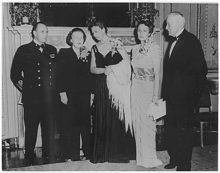 Crown Prince Olav of Norway, Princess Juliana, Eleanor Roosevelt, Crown Princess Märtha, and Thomas J. Watson in 1944
Crown Prince Olav of Norway, Princess Juliana, Eleanor Roosevelt, Crown Princess Märtha, and Thomas J. Watson in 1944
Princess Juliana's genuine warmth and the gestures of her Canadian hosts created a lasting bond which was reinforced when Canadian soldiers fought and died by the thousands in 1944 and 1945 to liberate the Netherlands from the Nazis. On 2 May 1945 she returned by a military transport plane with Queen Wilhelmina to the liberated part of the Netherlands, rushing to Breda to set up a temporary Dutch government. Once home she expressed her gratitude to Canada by sending the city of Ottawa 100,000 tulip bulbs. On 24 June 1945 she sailed on the RMS Queen Elizabeth from Gourock, Scotland, to the United States, listing her last permanent residence as London, England. The following year (1946), Juliana donated another 20,500 bulbs, with the request that a portion of these be planted at the grounds of the Ottawa Civic Hospital where she had given birth to Margriet. At the same time, she promised Ottawa an annual gift of tulips during her lifetime to show her lasting appreciation for Canada's war-time hospitality. Each year Ottawa hosts the Canadian Tulip Festival in celebration of this gift.
Return to the Netherlands
On 2 August 1945 Princess Juliana was reunited with her family on Dutch soil. Soon though, Prince Bernhard would become convinced that his children's manners had been thoroughly corrupted from their time in Canada. At their first family dinner at Soestdijk Palace, two-year-old Margriet beat a spoon on her plate,[citation needed] Irene sat with a comfortable leg curled under herself,[citation needed] and the seven-year-old future Queen Beatrix, who had already expressed the desire to return to Canada, talked incessantly with food in her mouth, complaining that she did not like her Dutch meal and wanted Canadian steak and ice cream like her mother had given them in Ottawa.[citation needed] The manner in which the children would be raised was a matter of disagreement between Princess Juliana and her husband. She believed that the days of an aloof, near-isolated monarchy were over, and that the royal children should interact as much as possible with average citizens.
Juliana immediately took part in a post-war relief operation for the people in the northern part of the country, where the Nazi-caused famine (the famine winter of 1944–1945) and their continued torturing and murdering of the previous winter had claimed many victims. She was very active as the president of the Dutch Red Cross and worked closely with the National Reconstruction organization. Her down to earth manner endeared her to her people so much that a majority of the Dutch people would soon want Queen Wilhelmina to abdicate in favour of her daughter. In the spring of 1946 Princess Juliana and Prince Bernhard visited the countries that had helped the Netherlands during the occupation.
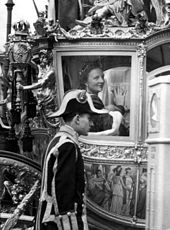 Queen Juliana in the Golden Carriage on the day of her inauguration as Queen in 1948
Queen Juliana in the Golden Carriage on the day of her inauguration as Queen in 1948
During her pregnancy with her last child, Marijke Christina, Princess Juliana contracted German measles. The girl was born in 1947 with cataracts in both eyes and was soon diagnosed as almost totally blind in one eye and severely limited in the other. Despite her blindness, Christina, as she was called, was a happy and gifted child with a talent for languages and, something long missing in the Dutch Royal Family, an ear for music. Over time, and with advances in medical technology, her eyesight did improve such that with thick glasses, she could attend school and even ride a bicycle. However, before that happened, her mother, the Princess, clinging to any thread that offered some hope for a cure, came under the spell of Greet Hofmans, a faith healer with heterodox beliefs considered by many[who?] to be a sham.
 Indonesian Vice-president Hatta and Dutch Queen Juliana at the signing ceremony in Amsterdam at which the Dutch recognized Indonesian sovereignty
Indonesian Vice-president Hatta and Dutch Queen Juliana at the signing ceremony in Amsterdam at which the Dutch recognized Indonesian sovereignty
For several weeks in the autumn of 1947 and again in 1948 the Princess acted as Regent when, for health reasons, Queen Wilhelmina was unable to perform her duties. The Independence in Indonesia, which saw more than 150,000 Dutch troops stationed there as decolonization force, was regarded as an economic disaster for the Netherlands. With the certain loss of the prized colony, the Queen announced her intention to abdicate. On 6 September 1948, with the eyes of the world upon her, Princess Juliana, the twelfth member of the House of Orange to rule the Netherlands, was inaugurated Queen in the Nieuwe Kerk in Amsterdam. On 27 December 1949 at Dam Palace in Amsterdam, Queen Juliana signed the papers that recognised Indonesian sovereignty over the former Dutch colony.
Queen of the Netherlands
Her daughter's blindness and the increasing influence of Hofmans, who had moved into a royal palace, severely affected the Queen's marital relationship. Over the next few years, the controversy surrounding the faith healer, at first kept out of the Dutch media, erupted into a national debate over the competency of the Queen. The people of the Netherlands watched as their Queen often appeared in public dressed like any ordinary Dutch woman. Queen Juliana began riding a bicycle for exercise and fresh air. The Queen wanted to be addressed as "Mevrouw" (Dutch for "Mrs.") by her subjects.
Although the bicycle and the down-to-earth manners suggest a simple life style, the Dutch Royal court of the 1950s and 1960s was still a splendid affair with chamberlains in magnificent uniforms, gilded state coaches, visits to towns in open carriages and lavish entertaining in the huge palaces. At the same time the Queen began visiting the citizens of the nearby towns and, unannounced, would drop in on social institutions and schools. Her refreshingly straightforward manner and talk made her a powerful public speaker. On the international stage, Queen Juliana was particularly interested in the problems of developing countries, the refugee problem, and had a very special interest in child welfare, particularly in the developing countries. The New York Times called her "an unpretentious woman of good sense and great goodwill."[citation needed]
On the night of 31 January 1953, the Netherlands was hit by the most destructive storm in more than five hundred years. Thirty breaches of dunes and dikes occurred and many towns were swept away by twelve-foot tidal waves. More than two thousand people drowned and tens of thousands were trapped by the floodwaters. Dressed in boots and an old coat, Queen Juliana waded through water and slopped through deep mud all over the devastated areas to bring desperate people food and clothing. Showing compassion and concern, reassuring the people, her tireless efforts would permanently endear her to the citizens of the Netherlands.
In 1956, the influence of Miss Hofmans on Juliana's political views would almost bring down the House of Orange in a constitutional crisis that caused the court and the royal family to split in a Bernhard faction set on removing a Queen considered religiously fanatic and a threat to NATO, and the Queen's pious and pacifist courtiers. The Prime Minister resolved the crisis. However, Juliana lost out to her powerful husband and his friends. Hofmans was banished from the court and Juliana's supporters were sacked or pensioned. Prince Bernhard planned to divorce his wife but decided against it when he, as he told an American journalist, "found out that the woman still loved him".
In 1963 Queen Juliana faced another crisis among the Protestant part of her people when her daughter Irene secretly converted to Roman Catholicism and, without government approval, on 29 April 1964 married Prince Carlos Hugo of Bourbon, Duke of Parma, a claimant to the Spanish throne and also a leader in Spain's Carlist party. With memories of the Dutch struggle for independence from Roman Catholic Spain and fascist German oppression still fresh in the minds of the Dutch people, the events leading to the marriage were played out in all the newspapers and a storm of hostility erupted against the monarchy for allowing it to happen — a matter so serious, the Queen's abdication became a real possibility. She survived, however, thanks to the underlying devotion she had earned over the years.
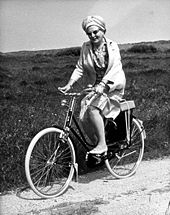 Queen Juliana riding a bicycle in 1967
Queen Juliana riding a bicycle in 1967
But crisis, as a result of marriage, would come again with the announcement in July 1965 of the engagement of Princess Beatrix, heir to the throne, to a German diplomat, Claus von Amsberg. The future husband of the future Queen had been a member of the Nazi Wehrmacht and the Hitler Youth movement. Many angry Dutch citizens demonstrated in the streets, and held rallies and marches against the "traitorous" affair. While this time upset citizens did not call for the Queen's abdication because the true object of their wrath, Princess Beatrix, would then be Queen, they did start to question the value of having a monarchy at all. After attempting to have the marriage cancelled, Queen Juliana acquiesced and the marriage took place under a continued storm of protest and an almost certain attitude pervaded the country that Princess Beatrix might be the last member of the House of Orange to ever reign in the Netherlands. Despite all these difficult matters, Queen Juliana's personal popularity suffered only temporarily.
The Queen was noted for her courtesy and kindness. In May 1959, for example, American ufologist George Adamski received a letter from the lady head of the Dutch Unidentified Flying Objects Society informing him that she had been contacted by Queen Juliana's palace and "that the Queen would like to receive you."[2] Adamski informed a London newspaper about the invitation, which prompted the court and cabinet to request that the Queen cancel her meeting with Adamski, but the Queen went ahead with the meeting saying that, "A hostess cannot slam the door in the face of her guests."[2] After the meeting, Dutch Aeronautical Association president Cornelis Kolff said, "The Queen showed an extraordinary interest in the whole subject."[2]
Dutch guilder with Juliana's portrait
An event in April 1967 brought an overnight revitalization of the Royal family, when the first male heir to the Dutch throne in 116 years, Willem-Alexander, was born to Princess Beatrix. This time the demonstrations in the street were ones of love and enthusiasm. This joyful occasion was helped along by an ever-improving Dutch economy.
Scandal rocked the Royal family again in 1976 when it was revealed that Prince Bernhard had accepted a $1.1 million bribe from U.S. aircraft manufacturer Lockheed Corporation to influence the Dutch government's purchase of fighter aircraft. The Prime Minister of the Netherlands ordered an inquiry into the affair while Prince Bernhard refused to answer reporters' questions, stating: "I am above such things." Rather than calling on the Queen to abdicate, the Dutch people were this time fearful that their beloved Juliana might abdicate out of shame or because of a criminal prosecution conducted in her name against her consort.
On 26 August 1976 a censored and toned-down, but devastating report on Prince Bernhard's activities was released to a shocked Dutch public. The Prince resigned his various high profile positions as a Lieutenant Admiral, a General and an Inspector General of the Armed Forces. The Prince resigned from his positions in the board of many businesses, charities, the World Wildlife Fund and other institutions. The Prince also accepted that he would have to give up wearing his beloved uniforms. In return, the States-General accepted that there was to be no criminal prosecution.
On her Silver Jubilee in 1973, Queen Juliana donated all of the money that had been raised by the National Silver Jubilee Committee to organizations for children in need throughout the world. She donated the gift from the nation which she received on her seventieth birthday to the "International Year of the Child."
She was the 922nd Lady of the Order of the Garter in 1958.
On 30 April 1980, the day of her 71st birthday, Queen Juliana abdicated and her eldest daughter succeeded her as Queen Beatrix of the Netherlands. Juliana remained active in numerous charitable causes until well into her eighties.
Illness and death
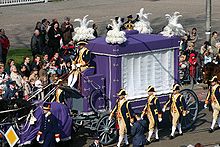 The Royal Hearse with the remains of the late Princess Juliana on its way to the Nieuwe Kerk in Delft
The Royal Hearse with the remains of the late Princess Juliana on its way to the Nieuwe Kerk in Delft
From the mid-1990s, Juliana's health declined and she also suffered the progressive onset of senility. Some have attributed this to Alzheimer's disease[citation needed], although this was denied by the Royal Family. Juliana did not appear in public after this time. At the order of the Royal Family's doctors, Juliana was placed under 24-hour care. Prince Bernhard publicly admitted in a television interview in 2001 that she was no longer able to recognise her family.
Juliana died in her sleep on 20 March 2004, several weeks before her 95th birthday, at Soestdijk Palace in Baarn from complications of pneumonia, exactly 70 years after her grandmother Emma.
She was embalmed (unlike her mother, who chose not to be) and on 30 March 2004 interred beside her mother, Wilhelmina, in the royal vaults under the Nieuwe Kerk in Delft. The memorial service made her ecumenical and often highly personal views on matters of religion public. The late Princess, a vicar told in her sermon, was interested in all religions and in reincarnation.
Juliana's husband, Prince Bernhard, died barely eight months after her, on 1 December 2004, aged 93 and his remains were placed next to hers.
Titles, Styles, Honours and Arms
Royal styles of
Queen Juliana of the Netherlands
Reference style Her Majesty Spoken style Your Majesty Alternative style Ma'am - Her Royal Highness Princess Juliana of the Netherlands, Princess of Orange-Nassau, Duchess of Mecklenburg (1909–1937)[3][4]
- Her Royal Highness Princess Juliana of the Netherlands, Princess of Orange-Nassau, Duchess of Mecklenburg, Princess of Lippe-Biesterfeld (1937–1948)[3][5]
- Her Royal Highness Princess Juliana of the Netherlands, Princess Regent (October 14, 1947–December 1, 1947; May 14, 1948–August 30, 1948)[6]
- Her Majesty Juliana, Queen of the Netherlands, Princess of Orange-Nassau, Duchess of Mecklenburg, Princess of Lippe-Biesterfeld (1948–1980)[3][7]
- Her Royal Highness Princess Juliana of the Netherlands, Princess of Orange-Nassau, Duchess of Mecklenburg, Princess of Lippe-Biesterfeld (1980–2004)[3]
Arms
As a Princess, Juliana bore the following arms: Quarterly, 1 and 3, Azure, billetty Or a lion with a coronet Or armed and langued Gules holding in his dexter paw a sword Argent hilted Or and in the sinister paw seven arrows Argent pointed and bound together Or (the royal arms of dominion of the Netherlands, and thus her mother Queen Wilhelmina), 2 and 4, Or, a Horn azure, langued gules, (the arms of the Principality of Orange) on an inescutcheon or, a Bull's head sable (for her father's House of Mecklenburg). On her accession to the throne in 1948, Juliana adopted the arms of Dominion of the Netherlands. i.e., Azure, billetty Or a lion with a coronet Or armed and langued Gules holding in his dexter paw a sword Argent hilted Or and in the sinister paw seven arrows Argent pointed and bound together Or.
Issue
Name Birth Marriage Date Spouse Issue Queen Beatrix 31 January 1938 10 March 1966
(widowed in 2002)Claus von Amsberg Prince Willem-Alexander
Prince Friso
Prince ConstantijnPrincess Irene 5 August 1939 29 April 1964
(divorced in 1981)Carlos Hugo, Duke of Parma Carlos, Duke of Parma
Princess Margarita
Prince Jaime
Princess CarolinaPrincess Margriet 19 January 1943 10 January 1967 Pieter van Vollenhoven Prince Maurits
Prince Bernhard
Prince Pieter-Christiaan
Prince FlorisPrincess Christina 18 February 1947 28 June 1975
(divorced in 1996)Jorge Pérez y Guillermo Bernardo Guillermo
Nicolás Guillermo
Juliana GuillermoAncestry
See also: Dutch monarchs family treeAncestors of Juliana of the Netherlands 16. Frederick Louis, Hereditary Grand Duke of Mecklenburg-Schwerin 8. Paul Frederick, Grand Duke of Mecklenburg-Schwerin 17. Grand Duchess Elena Pavlovna of Russia 4. Frederick Francis II, Grand Duke of Mecklenburg-Schwerin 18. Frederick William III of Prussia 9. Princess Alexandrine of Prussia 19. Duchess Louise of Mecklenburg-Strelitz 2. Duke Hendrik of Mecklenburg-Schwerin 20. Prince Carl of Schwarzburg-Rudolstadt 10. Prince Adolph of Schwarzburg-Rudolstadt 21. Landgravine Ulrike of Hesse-Homburg 5. Princess Marie of Schwarzburg-Rudolstadt 22. Otto Victor, Prince of Schönburg-Waldenburg 11. Princess Mathilde of Schonburg-Waldenburg 23. Princess Thekla of Schwarzburg-Rudolstadt 1. Juliana of the Netherlands 24. William I of the Netherlands 12. William II of the Netherlands 25. Princess Wilhelmine of Prussia 6. William III of the Netherlands 26. Paul I of Russia 13. Grand Duchess Anna Pavlovna of Russia 27. Duchess Sophie Dorothea of Württemberg 3. Wilhelmina of the Netherlands 28. George II, Prince of Waldeck and Pyrmont 14. George Victor, Prince of Waldeck and Pyrmont 29. Princess Emma of Anhalt-Bernburg-Schaumburg-Hoym 7. Princess Emma of Waldeck and Pyrmont 30. William, Duke of Nassau 15. Princess Helena of Nassau 31. Princess Pauline of Württemberg Prime Ministers during the Queen's reign
- Prime Ministers of the Netherlands
- Willem Drees (1948–1958)
- Louis Beel (1958–1959)
- Jan de Quay (1959–1963)
- Victor Marijnen (1963–1965)
- Jo Cals (1965–1966)
- Jelle Zijlstra (1966–1967)
- Piet de Jong (1967–1971)
- Barend Biesheuvel (1971–1973)
- Joop den Uyl (1973–1977)
- Dries van Agt (1977–1982)
- Prime Ministers of the Netherlands Antilles
- Moises Frumencio da Costa Gomez (1949)
- Lindoro Christoffel Kwartsz (1949–1951)
- Moises Frumencio da Costa Gomez (1951–1954)
- Efraïn Jonckheer (1954–1968)
- Ciro Domenico Kroon (1968–1969)
- Gerald C. Sprockel (1969)
- Ernesto O. Petronia (1969–1971)
- Ramez Jorge Isa (1971)
- Otto R.A. Beaujon (1971–1973)
- Juancho Evertsz (1973–1977)
- Lucinda da Costa Gomez-Matheeuws (1977)
- Leo A.I. Chance (1977)
- Silvius Gerard Marie Rozendal (1977–1979)
- Miguel A. Pourier (1979)
- Dominico Martina (1979–1984)
- Prime Ministers of Suriname
- Julius Caesar de Miranda (1949–1951)
- Jacques Adam Drielsma (1951–1951)
- Johann Ate Eldert Buiskool (1951–1952)
- Adrian Cornelis Jasper Marous Alberga (1952)
- Archibald Currie (1952–1955)[8]
- Johan Ferrier (1955–1958)
- Severinus Désiré Emanuels (1958–1963)
- Johan Adolf Pengel (1963–1969)
- Arthur J. May (1969)[9]
- Jules Sedney (1969–1973)
- Henck Alphonsus Eugène Arron (1973–1980)[10]
References
- ^ CBC Digital Archives: "Netherlands' Princess Margriet born in Ottawa"
- ^ a b c "The Queen & the Saucers". Time (magazine). 1 June 1959. http://www.time.com/time/magazine/article/0,9171,811123,00.html. Retrieved 2007-04-27.
- ^ a b c d H.M. (koningin Juliana) Juliana Louise Emma Marie Wilhelmina (Parlement.nl)
- ^ Decree about the titles and names of the descendants of HM Queen Wilhemina - Website with Legislation concerning the Royal House of the Netherlands (Dutch)
- ^ Decree of granting the title "Princess of Lippe-Biesterfeld" to HRH Prince Juliana - Website with Legislation concerning the Royal House of the Netherlands (Dutch)
- ^ Besluit tot uitvoering van artikel 12 der Wet buitengewoon pensioen 1940-1945 (BWBR0002042)
- ^ Wet op het Kroondomein (BWBR0002752)
- ^ Acting Prime Minister from 1952 to 1954.
- ^ Acting Prime Minster
- ^ Suriname became independent in 1975.
External links
- Juliana van Oranje-Nassau (1909-2004) on Familypedia
- Queen Juliana (1909-2004) at the Dutch Royal House website
- Princess Juliana, Former Dutch Monarch, Is Dead at 94 Obituary The New York Times
Juliana of the NetherlandsCadet branch of the House of Mecklenburg-SchwerinBorn: 30 April 1909 Died: 20 March 2004Regnal titles Preceded by
WilhelminaQueen of the Netherlands
6 September 1948 – 30 April 1980Succeeded by
BeatrixDutch royalty Preceded by
William ErnestHeir to the Dutch throne
as heiress presumptive
1909–1948Succeeded by
Princess Beatrix
later became Queen BeatrixMonarchs of the Netherlands House of Orange-Nassau 1st Generation 2nd Generation 3rd Generation 4th Generation Juliana5th Generation 6th Generation none7th Generation Categories:- 1909 births
- 2004 deaths
- Deaths from pneumonia
- Dutch monarchs
- Dutch Reformed Christians from the Netherlands
- Female regents
- Heirs presumptive to the Dutch throne
- House of Mecklenburg-Schwerin
- House of Orange-Nassau
- Infectious disease deaths in the Netherlands
- Grand Crosses Special Class of the Order of Merit of the Federal Republic of Germany
- Leiden University alumni
- Protestant monarchs
- People with dementia
- Monarchs who abdicated
- Queens regnant
- Recipients of the Royal Victorian Chain
- Grand Masters of the Military William Order
- Duchesses of Mecklenburg-Schwerin
- Burials in the Royal Crypt at Nieuwe Kerk, Delft
- Members of the Council of State of the Netherlands
- Recipients of the Order of the White Eagle (Poland)
- Grand Masters of the Order of the Netherlands Lion
- Grand Masters of the Order of the Gold Lion of the House of Nassau
- Grand Masters of the Order of the House of Orange
- Grand Masters of the Order of Orange-Nassau
- Ladies of the Garter
- Dames of the Order of the Rajamitrabhorn
- Dames of the Order of the Royal House of Chakri
- Knights Grand Cross with Collar of the Order of St. Olav
Wikimedia Foundation. 2010.


